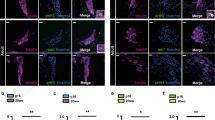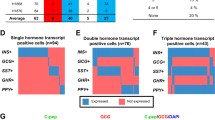Abstract
Expanding the number of insulin-producing beta cells through reactivation of their replication has been proposed as a therapy to prevent or delay the appearance of diabetes. Using antibody arrays, we identified CCN4/Wisp1 as a circulating factor enriched in preweaning mice, a period in which beta cells exhibit a dramatic increase in number. This finding led us to investigate the involvement of CCN4 in beta cell proliferation. We demonstrated that CCN4 promotes adult beta cell proliferation in vitro in cultured isolated islets, and in vivo in islets transplanted into the anterior chamber of the eye. In this chapter, we present the methodology that was used to study proliferation in both settings.
Access this chapter
Tax calculation will be finalised at checkout
Purchases are for personal use only
Similar content being viewed by others
References
Wang P, Fiaschi-Taesch NM, Vasavada RC, Scott DK, García-Ocaña A, Stewart AF (2015) Diabetes mellitus--advances and challenges in human β-cell proliferation. Nat Rev Endocrinol 11(4):201–212
Conboy IM, Conboy MJ, Wagers AJ, Girma ER, Weissman IL, Rando TA (2005) Rejuvenation of aged progenitor cells by exposure to a young systemic environment. Nature 433:760–764
Song G, Nguyen DT, Pietramaggiori G, Scherer S, Chen B, Zhan Q, Ogawa R, Yannas IV, Wagers AJ, Orgill DP et al (2010) Use of the parabiotic model in studies of cutaneous wound healing to define the participation of circulating cells. Wound Repair Regen 18:426–432
Villeda SA, Luo J, Mosher KI, Zou B, Britschgi M, Bieri G, Stan TM, Fainberg N, Ding Z, Eggel A et al (2011) The ageing systemic milieu negatively regulates neurogenesis and cognitive function. Nature 477:90–94
Riley KG, Pasek RC, Maulis MF, Peek J, Thorel F, Brigstock DR, Herrera PL, Gannon M (2015) Connective tissue growth factor modulates adult β-cell maturity and proliferation to promote β-cell regeneration in mice. Diabetes 64:1284–1298
Bornstein P (2009) Matricellular proteins: an overview. J Cell Commun Signal 3:163–165
Stephens S, Palmer J, Konstantinova I, Pearce A, Jarai G, Day E (2015) A functional analysis of Wnt inducible signalling pathway protein −1 (WISP-1/CCN4). J Cell Commun Signal 9:63–72
Viloria K, Hill NJ (2016) Embracing the complexity of matricellular proteins: the functional and clinical significance of splice variation. Biomol Concepts 7(2):117–132
Gerarduzzi C, Hartmann U, Leask A, Drobetsky E (2020) The matrix revolution:matricellular proteins and restructuring of the cancer microenvironment. Cancer Res 80(13):2705–2717
Frangogiannis NG (2012) Matricellular proteins in cardiac adaptation and disease. Physiol Rev 92:635–688
Yeger H, Perbal B (2007) The CCN family of genes: a perspective on CCN biology and therapeutic potential. J Cell Commun Signal 1:159–164
Shi W, Yin J, Chen Z, Chen H, Liu L, Meng Z (2014) Cyr61 promotes growth of pancreatic carcinoma via nuclear exclusion of p27. Tumor Biol 35:11147–11151
Fernandez-Ruiz R, García A, Esteban Y, Mir J, Serra Navarro B, Fontcuberta-PiSunyer M, Broca C, Armanet M, Wojtusciszyn A, Kram V, Young MF, Vidal J, Gomis R, Gasa R (2020) Wisp1 is a circulating factor that stimulates proliferation of adult mouse and human beta cells. Nat Commun 11:5982
Maeda A, Ono M, Holmbeck K, Li L, Kilts TM, Kram V, Noonan ML, Yoshioka Y, McNerny EMB, Tantillo MA et al (2015) WNT1-Induced Secreted Protein-1 (Wisp1), a novel regulator of bone turnover and Wnt signaling. J Biol Chem 290:14004–14018
Murahovschi V, Pivovarova O, Ilkavets I, Dmitrieva RM, Döcke S, Keyhani-Nejad F, Gögebakan Ö, Osterhoff M, Kemper M, Hornemann S et al (2015) WISP1 is a novel adipokine linked to inflammation in obesity. Diabetes 64:856–866
Pivovarova-Ramich O, Loske J, Hornemann S, Markova M, Seebeck N, Rosenthal A, Klauschen F, Castro JP, Buschow R, Grune T, Lange V, Rudovich N, Ouwens DM (2021) Hepatic Wnt1 inducible signaling pathway protein 1 (WISP-1/CCN4) associates with markers of liver fibrosis in severe obesity. Cell 10(5):1048
Corbin KL, West HL, Brodsky S, Whitticar NB, Kock WJ, Nunemaker CS (2021) A practical guide to rodent isolation and assessment revisited. Biol Proced Online 23:7. https://doi.org/10.1186/s12575-021-00143-x
Speier S, Nyqvist D, Köhler M, Caicedo A, Leibiger IB, Berggren PO (2008) Noninvasive high-resolution in vivo imaging of cell biology in the anterior chamber of the mouse eye. Nat Protoc 3(8):1278–1286
Villarreal D, Pradhan G, Wu CS, Allred CD, Guo S, Sun Y (2019) A simple high efficiency protocol for pancreatic islet isolation from mice. J Vis Exp (150):e57048
Zmuda EJ, Powell CA, Hai T (2011) A method for murine islet isolation and subcapsular kidney transplantation. J Vis Exp (50):e2096. https://doi.org/10.3791/2096
Author information
Authors and Affiliations
Corresponding author
Editor information
Editors and Affiliations
Rights and permissions
Copyright information
© 2023 The Author(s), under exclusive license to Springer Science+Business Media, LLC, part of Springer Nature
About this protocol
Cite this protocol
Fernández-Ruiz, R., Gasa, R. (2023). Evaluation of the Effects of CCN4 on Pancreatic Beta Cell Proliferation. In: Takigawa, M. (eds) CCN Proteins. Methods in Molecular Biology, vol 2582. Humana, New York, NY. https://doi.org/10.1007/978-1-0716-2744-0_13
Download citation
DOI: https://doi.org/10.1007/978-1-0716-2744-0_13
Published:
Publisher Name: Humana, New York, NY
Print ISBN: 978-1-0716-2743-3
Online ISBN: 978-1-0716-2744-0
eBook Packages: Springer Protocols




